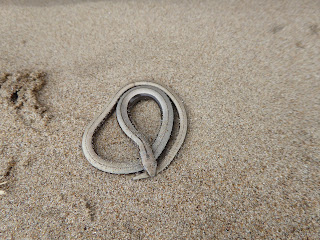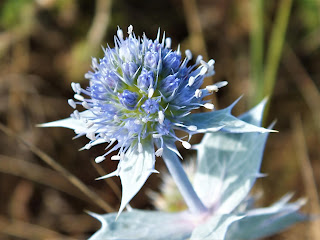This is easily evidenced by looking at the increasing numbers of birds which come to Carmarthen Bay, and specifically Cefn Sidan and Pembrey Burrows, to spend the winter.
The gull numbers are building up with good numbers of COMMON GULL, BLACK HEADED GULL and HERRING GULL using the fields in the country park at high tide; the SANDWICH TERN roost at Old Pembrey Harbour reached 171 birds yesterday evening, (before being disturbed by a big green canoe). Along the beach SANDERLING, RINGED PLOVER, DUNLIN and TURNSTONE are to be found chasing the tide. A juvenile MARSH HARRIER was recorded by Bernie Beck this week- thanks Bernie.
More significant, although harder to see, are the big numbers of the schedule 1 protected sea duck the COMMON SCOTER, I counted over 3000 yesterday and more than 2000 this morning. The UK breeding population of this sea duck is less than 100 pairs, it being mainly a bird of the Arctic and Scandinavian regions.
 |
| A typical view of Common Scoter |
In 1996 a population of around 10000 birds wintered off Milford Haven then disaster struck with the grounding of the Sea Empress oil tanker which leaked oil into the sea resulting in the deaths of thousands of birds including a recorded 1700 Common Scoter.BY 2003 numbers had recovered to around 17000 wintering birds. Most surveys were carried out using aerial counts, cost cuts meant that the counts were suspended for many years, however in the winters of 2016 and 2017 counts were restarted and some 36000 wintering Common Scoter were counted.
The Carmarthen Bay SPA, (the first fully marine Special Protected Area in the UK was created in 2003 purely for the Common Scoter) holds significant numbers of this enigmatic dark plumaged duck.
 |
| Female and Male |
Currently a good viewing point is at CE56, the main beach access in the country park, just stand on a high dune, or from CE57 where there is a viewing platform, the flock has been around 1km off shore looking towards Worms Head.
All photos Wikipedia free to use and share, my camera is not up to the job
























